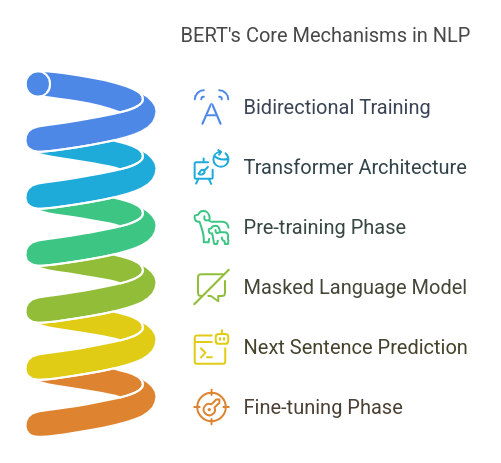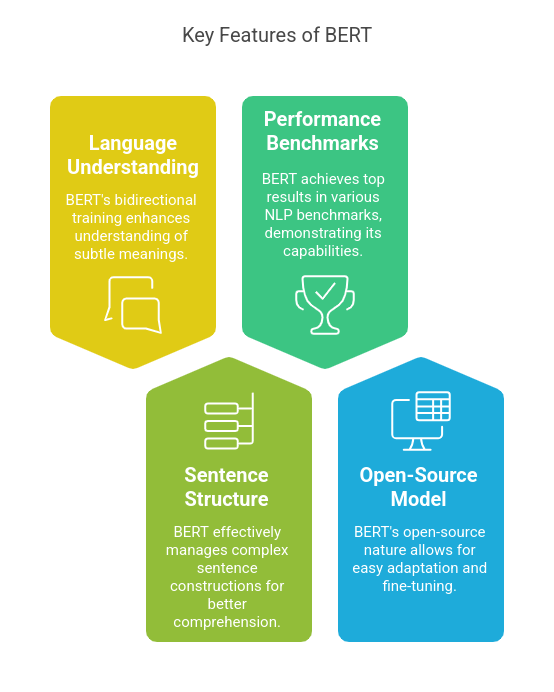Enhancing Search Understanding with BERT
Have you ever wondered how Google can understand your search queries so accurately? The answer lies in BERT, a powerful AI language model developed by Google in 2018. Unlike traditional models, BERT looks at words bidirectionally, considering both preceding and following words to grasp their true meaning. Let’s delve into how BERT works and why it’s transforming natural language processing.
Understanding BERT
BERT, short for Bidirectional Encoder Representations from Transformers, is a language model that revolutionized NLP. By reading text bidirectionally, BERT captures the complete context of a word, leading to a deeper understanding of language nuances.
- Bidirectional Context: BERT analyzes text from both directions to understand the full context of a word.
- Transformer Architecture: BERT uses transformers to focus on relationships between words in a sentence simultaneously.
- Pre-training and Fine-tuning: BERT is pre-trained on large text datasets to learn language patterns and can be fine-tuned for specific tasks.
BERT’s bidirectional approach is crucial in NLP as it enables models to comprehend the meaning of words based on their context, resulting in more accurate interpretations, especially in complex sentences.
The Core Mechanisms of BERT
BERT’s groundbreaking model in NLP is powered by bidirectional training, transformer architecture, and a two-step learning process.

Bidirectional Training
BERT’s bidirectional training allows it to understand the context of a word by scanning both preceding and following words, unlike traditional models that process text unidirectionally.
Transformer Architecture
BERT’s core is the Transformer model, which uses a self-attention mechanism to weigh the importance of each word in a sentence, enhancing contextual understanding.
Pre-training and Fine-tuning
BERT undergoes pre-training on large text corpora through tasks like Masked Language Modeling and Next Sentence Prediction before fine-tuning for specific applications.
Masked Language Model (MLM)
BERT predicts missing words in sentences through the MLM task, enhancing its understanding of language patterns.
Next Sentence Prediction (NSP)
Through NSP, BERT learns to predict if one sentence logically follows another, improving its comprehension of sentence relationships.
Key Features and Applications of BERT

- Improved Understanding of Language subtleties and Polysemy
- Effective Handling of Complex Sentence Structures
- State-of-the-Art Performance in NLP Benchmarks
- Open-Source Availability and Adaptability
Real-World Applications
- Search Engines: BERT enhances search accuracy by understanding user queries better.
- Chatbots and Virtual Assistants: BERT enables more natural conversations by improving context understanding.
- Sentiment Analysis: BERT’s deep contextual understanding enhances sentiment classification accuracy.
- Machine Translation and Text Summarization: BERT improves translation and summarization quality through context-sensitive processing.
By leveraging its features, BERT plays a vital role in advancing NLP and is essential for professionals in AI-driven fields.
Future of BERT and NLP Advancements
NLP has evolved rapidly since the introduction of BERT, leading to advanced models like RoBERTa, ALBERT, and T5. These models are reshaping NLP with improvements in training methodologies and efficiency.
Evolution into Advanced Models
- RoBERTa: Enhances training methodologies for improved performance on NLP tasks.
- ALBERT: Minimizes model size while maintaining performance and efficiency.
- T5: Redefines NLP tasks under a single text-to-text framework for versatile processing.
Integration with Multimodal AI Systems
NLP systems are integrating with other modalities like images and videos for enhanced content understanding and production.
Optimizations for Efficiency and Deployment
Efforts are being made to optimize NLP models for deployment in low-resource environments using techniques like knowledge distillation and quantization.
These advancements promise a future of more capable, versatile, and efficient NLP models with broader real-world applications.
Conclusion
BERT’s impact on NLP has been profound, driving advancements in models and applications. As NLP evolves, mastering technologies like BERT is crucial for success in AI-driven industries.
If you’re interested in NLP and machine learning, explore Great Learning’s AI course for hands-on experience in cutting-edge AI applications.
For more insights into NLP concepts, check out our free NLP courses.



